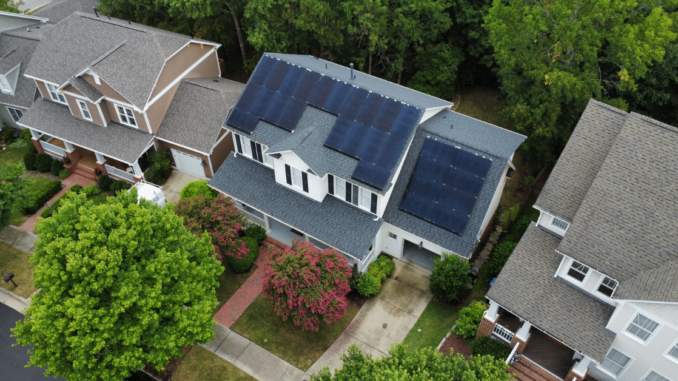
It’s called the “solar coaster:” The ups and downs the industry faces as solar-friendly policies ebb and flow. And in North Carolina, rooftop installers are in the middle of one wild ride.
On the heels of cutting bill credits for residential solar panels in October, Duke Energy is now poised to offer new rebates for rooftop arrays that are paired with batteries. Combined with federal incentives, the new “PowerPair” rebates could cut the cost of solar and battery systems in half and inject new interest in rooftop solar, which many installers say waned last fall.
“We definitely saw a dip,” said Doug Ager, the CEO and co-founder of Sugar Hollow Solar, describing his company’s business in the last quarter of 2023. But at least in the short-term, he said, “PowerPair will change all that.”
Approved to roll out in May, the pilot program will initially serve only an estimated 6,000 to 7,000 households. But proponents say it could pave the way for a new paradigm in which Duke invests in and manages distributed renewable energy and storage the same way it might a traditional power plant.
“It’s opening the door to active load management from Duke that is going to be increasingly important,” said David Neal, the senior attorney with the Southern Environmental Law Center who helped negotiate the program. Heralding the pilot as one of the first of its kind, he said, “it’s going to be a lot more cost effective than just building new generation to meet expected loads.”
Ultimately, advocates are also hopeful that the solar coaster can be smoothed out a little.
“The rooftop solar industry really has experienced quite a bit of ups and downs,” said Matt Abele, executive director of the North Carolina Sustainable Energy Association, which also helped devise the rebates. There’s still the question of what long-term strategies would support installers, he said. “But I would say this is not an insignificant program in the interim.”
Greenlit by regulators last month, the rebates grew out of a years-long dispute between Duke Energy, advocates, and the solar industry about how rooftop solar owners should be compensated for the electricity they produce.
About 40,000 rooftops across the state boast solar arrays, the bulk of them on homes and in Duke territory. The figure accounts for a tiny fraction of North Carolina’s roughly 5 million housing units.
Despite these small numbers, Duke, like other investor-owned utilities around the country, has long sought to lower the state’s one-to-one net metering credit, which it says unfairly burdens both the company and customers that don’t have solar panels.
Solar installers and advocates contend that rooftop arrays provide more benefits than costs, including cleaner air, fewer electrons lost in transmission, and reduced need for electricity from centralized fossil fuel power plants. Their assertion is backed up by most independent studies of rooftop solar, a 2019 analysis found.
Still, a pair of state laws, both heavily influenced by Duke, mandate a change to the current net metering scheme by 2027. To avoid the bruising battles and excessive fees on solar customers seen in California and elsewhere, some of the state’s leading clean energy advocates and solar installers forged a complicated truce with the utility.
The crux of the agreement is a move toward “time of use” billing. New residential solar owners are charged and rewarded more for electrons they add to or subtract from the grid during peak demand hours of 6 to 9 p.m. in the summer and 6 to 9 a.m. in the winter. On a monthly basis, any net solar electrons added to the grid are credited at the “avoided cost” rate — akin to a wholesale rate and currently about 3.4 cents per kilowatt hour.
Diligent solar owners can squeeze benefits out of this complex billing scheme, some installers say. But to ease the transition, they also negotiated a simpler, lower-risk “bridge rate” with Duke, in which solar customers enrolling before 2027 get a monthly credit at the wholesale rate for any electrons they add to the grid.
Regulators on the utilities commission accepted these compromises last March and ultimately ordered new rates to begin October 1. But they rejected another component of the deal, which would have given customers with electric heat an extra rebate for enrolling in Duke’s smart thermostat program, in which the utility can make temperature adjustments from afar.
“Instead, the Commission directs Duke to develop a pilot program,” their order read, “to evaluate operational impacts to the electric system, if any, of behind the meter residential solar plus energy storage.”
PowerPair is the result. “This program was in many ways a result of our negotiations around net metering,” Dave Hollister, the president of Sundance Power Systems, said over email.
Devised after months of conversations between Duke, solar installers, clean energy advocates, and others, the new rebates would be based on the size of the solar array and battery and capped at $3,600 and $5,400 respectively. Combined with a 30% federal tax credit, the cash back could cut the cost of an average $40,500 system down to less than $20,000.
For customers, the deal is “actually really, really good in terms of the economics,” one installer said. And for Duke, the rebates could prove a low-cost strategy for smoothing out spikes in demand and strengthening the resilience of the grid.
“Cost effective and dispatchable customer-sited resources are key components of our clean energy transition,” Lon Huber, a senior vice president at Duke, said in an email. “We are committed to expanding the scope and adding ways for our customers to deploy grid beneficial technology.”
Customers will be divided into two equal cohorts. Those subscribed to the simpler bridge will allow the utility to remotely control their battery up to 18 times a year and will earn an extra $37 a month on average. Enrollees in the more complicated time-of-use rate plan, on the other hand, won’t get monthly incentives but would have control of their batteries.
“It will be interesting to see how many folks will allow Duke to control their battery and who wants to have that freedom and independence to manage their customer-generated electricity themselves,” Hollister said. “ We deal with so many folks who are looking for self-reliance and the idea of ‘smart grid’ is somewhat of a third rail for them.”
Already, batteries are popular options for rooftop solar customers. Installers say between a quarter and 40% of their clients were already choosing them for a variety of reasons, from a desire to save money to a quest for energy security in the face of outages.
Sugar Hollow Solar’s Ager said residential storage fits with the western North Carolina vibe. “Being in the mountains,” he said, “people just want batteries.”
With the PowerPair, the percentage of solar arrays paired with storage will undoubtedly rise, and many installers predicted it would double.
“I fully anticipate us selling tons of systems with batteries,” said Brandon Pendry, communications and outreach specialist with Southern Energy Management, one of the state’s oldest installers and a negotiator for both the bridge rate and the PowerPair scheme.
To avoid the problem installers and their clients faced with the last round of rooftop solar rebates — when demand far exceeded supply each year and available grants disappeared in minutes — the architects of the program gave it an overall cap of 60,000 kilowatts but no annual limits. That way, rooftop solar and battery owners can get the rebates on a rolling basis.
“In this case, there is only one capacity and it’s not time dependent,” said Pendry. “It’s just: when it runs out, it runs out.”
If customers choose the maximum allowable size of a 10 kilowatt solar array, a total of 6,000 households could benefit. But no one really knows when the capacity will be reached, with some predicting 18 months from May and others estimating as few as four.
Duke projects it will connect 11,400 residential rooftop systems this year. But a spokesperson said it was simply too early to tell when PowerPair rebates would dry up.
Once they do, the hope is that data gathered during the pilot will inform whatever comes next.
“It may possibly be a win-win for everyone,” Hollister said, “especially if it can be extended or transformed into a more permanent program.”
Since half of the PowerPair cohorts will be using the bridge rate, there’s some chance a permanent program would extend that rate’s life — a key priority for some in the industry.
No matter what, while most installers contacted for this article eagerly await the pilot, they’re also clear-eyed about their business plan for the future.
“We have been installing solar in [the state] for over a decade and have certainly seen lots of incentives come and go, said Jesse Solomon, vice president and director of sales for N.C Solar Now, in an email. “But we have always been able to design the investment to make sense for our clients.”
Solar installers also focus on the overall trends buoying their industry: Fossil fuels are becoming more expensive, while the materials designed to harness and store forever-free sunlight are getting cheaper.
Every year Duke raises rates, said Pendry of Southern Energy Management, “solar becomes a better and better investment.”



